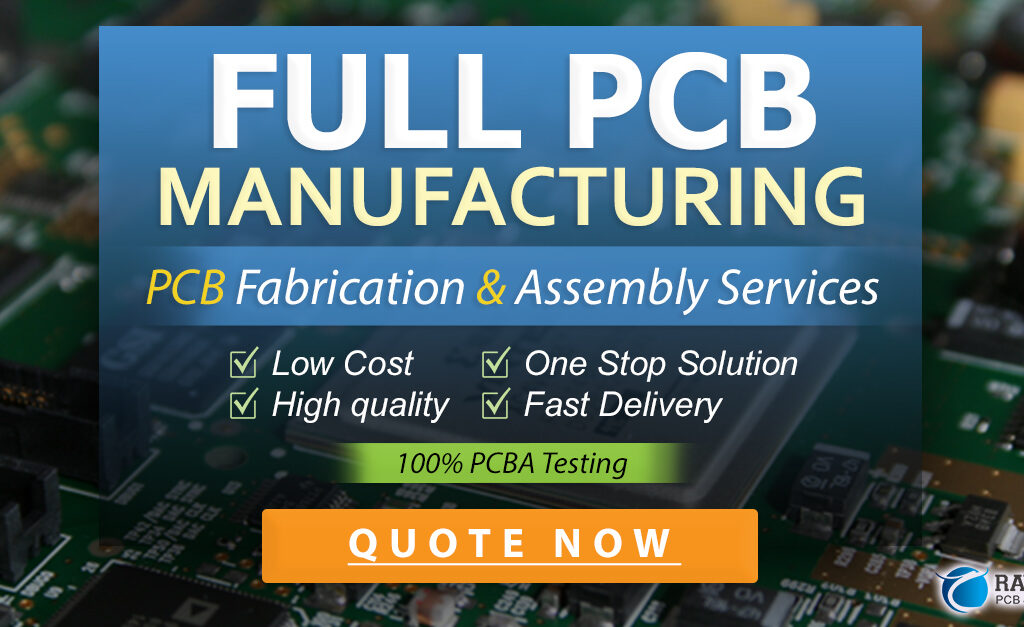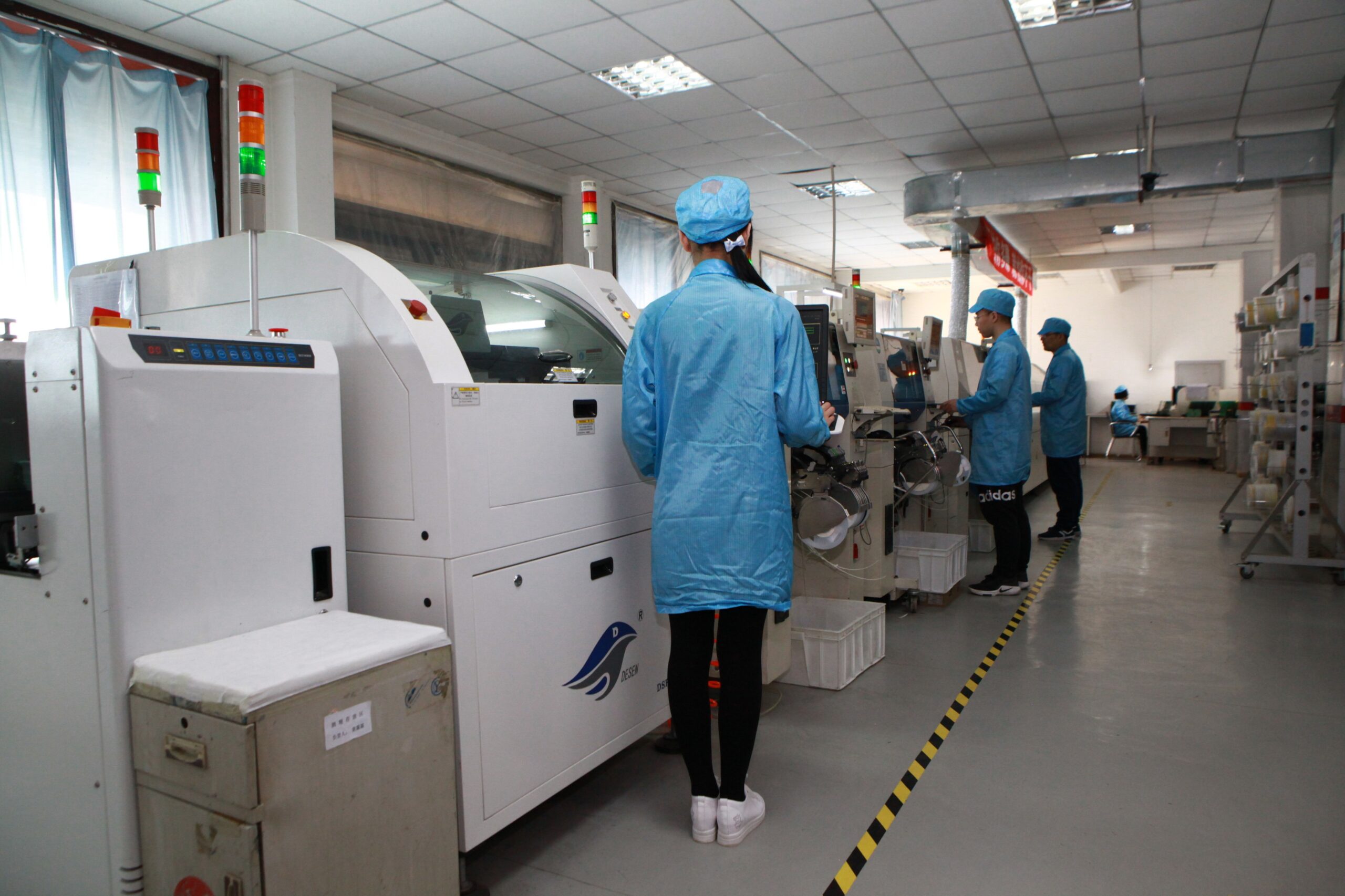Who is the largest PCB manufacturer in North America?
The printed circuit board (PCB) manufacturing landscape in North America has undergone consolidation over the past decade. A few leading fabricators now dominate the majority of production driven by high-volume consumer electronics, telecom infrastructure, and advanced automation capabilities.

This article analyzes the top 10 North American PCB manufacturers based on annual revenues and production capacity. We rank the largest companies and provide overviews of their capabilities:
Top 10 North American PCB Companies
The table below ranks the top 10 manufacturers of PCBs in North America as of 2023:
| Rank | Company | Headquarters | Est. Revenues |
|-|-|-|-|
| 1 | TTM Technologies | CA, USA | $2.5 billion |
| 2 | Sanmina Corporation | CA, USA | $2 billion* |
| 3 | AT&S | ON, Canada | $1.74 billion †|
| 4 | IEC Electronics Corp | NY, USA | $615 million‡|
| 5 | MC Assembly | MA, USA | $430 million|
| 6 | Flex | CA, USA | $386 million|
| 7 | Sierra Circuits | CA, USA | $300 million|
| 8 | Calumet Elecronics Corp | IN, USA | $285 million|
| 9 | Creation Technologies | BC, Canada | $250 million|
| 10 | SigmaTron Intl | IL, USA | $200 million|
PCB production in North America totaled over $9.5 billion during 2022. The rankings above cover over 70% of this output led by TTM, Sanmina, and AT&S. Next we analyze their manufacturing footprints across the continent.
1. TTM Technologies
Headquarters: Anaheim, CA, USA
TTM Technologies is the leading PCB manufacturer in North America offering the widest production capabilities in technology and scale. Key facts:
Revenue: $2.5 billion
Facilities: 10 plants in USA
PCBs produced annually: Over 500,000 sq. meters
Technologies: HDI, flexible, rigid-flex, RF boards, rigid multilayer
End markets: Aerospace and defense, automotive, cellular infrastructure, medical, networking
Certifications: AS9100, ISO9001, ISO14001, OHSAS18001, ITAR Registered
TTM operates some of the most advanced PCB factories in the US spanning over 1.6 million sq ft manufacturing space. They specialize in prototyping through volume production of boards with lines capable of handling over 18 million multilayer PCBs per year.
2. Sanmina Corporation
Headquarters: San Jose, CA, USA
Sanmina manufactures printed circuit boards and provides electronics manufacturing services (EMS) to OEMs across industries.
Revenue: ~$2 billion (Estimated PCB division)
Facilities: 30+ locations worldwide of which 6 are in NA with PCB capabilities
PCBs capabilities: Multi-layer PCBs, HDI Microvia, Flex and rigid-flex boards
Key end markets served include communications, computing and cloud infrastructure, defense and aerospace, industrial, automotive, medical, clean technology and LED lighting.
Sanmina houses over 2.5 million square feet of manufacturing space in North America with sites certified for ISO, AS9100, and ITAR standards as needed by defense projects.
3. AT&S
Headquarters: Leoben, Austria
North America presence: Toronto, Canada + Mexico
AT&S is Europe’s largest PCB producer with a growing presence in North America after acquiring Axixon in 2022. Some facts:
2022 Revenue: €1.6 billion globally
Facilities: 8 plants worldwide – 1 plant in Canada, 1 plant in Mexico
PCB capabilities: IC substrates, HDI microvia, rigid multilayer, flexible boards
North America capacity: Over $200 million revenue
As part of its global capacity expansion strategy, AT&S set up a technology center and factory in Toronto, Canada to cater to the growing American and Canadian 5G and infrastructure markets. The location provides access to local supply chains in NA offering specialized PCB prototypes and high-mix volume production focused on automotive, industrial and healthcare applications.
4. IEC Electronics Corp
Headquarters: Newark, NY, USA
IEC manufactures custom electronic assemblies and PCBs focused on low-to-medium volume, high-mix products for military, aerospace, and specialty industrial applications. They were recently acquired by Creation Technologies.
Revenue: $615 million (TTM 2021)
Facilities: 8 US locations, majority in NY and MA
PCB Capabilities: Rigid, flexible, rigid-flex PCBs
Assembly capabilities: Box-build, systems integration
Certifications: ISO9001, ISO13485, AS9100D, ITAR, Nadcap accreditations
IEC deals with high complexity PCBs and products involving multiple technologies like embedded systems married to flex-rigid boards. Their manufacturing models are aligned to rapid prototyping into low rate production suited to defense and medical requirements.
5. MC Assembly
Headquarters: Billerica, MA, USA
MC Assembly provides PCB assembly, systems integration, and manufacturing engineering services catering primarily to medical, industrial equipment, and IoT (Internet-of-Things) customers.
Revenue: Over $430 million
Facilities: Headquarters in Massachusetts with sites across US and Mexico
PCB Offerings: Quick-turn prototyping, low volume through high mix PCB assembly focused on SMT
MC Assembly has carved a niche in mid-volume manufacturing of highly complex boards and assemblies primarily used in diagnostic imaging systems, patient monitoring, dialysis equipment, scanning systems. They leverage automation in packaging and inspection while providing proprietary processes that ensure product reliability.
6. Flex
Headquarters: Santa Clara, California
Flex specializes in electronics design, advanced PCBs and manufacturing services spanning consumer products, automotive, health, industrial, aerospace/defense industries.
Revenue: $386 million PCB, $1 billion systems assembly
Facilities: 20+ locations worldwide, including 6 in North America
PCB capabilities: Rigid-flex boards, flexible printed circuits (FPCs), HDI multilayer in Asia
Flex runs an HDI facility in China serving North American customers. Within NA, it focuses more on new product engineering, testing and specialized flex/rigid-flex PCB assemblies drawing over $1 billion in systems manufacturing revenue.
7. Sierra Circuits
Headquarters: Sunnyvale, California
Sierra is an award-winning prototyping house providing quick-turn rigid PCB fabrication catering to startups & Silicon Valley engineers.
Revenue: Over $300 million
Facilities: Headquarters in CA with second site in TX, USA
PCB capabilities: Rigid multilayer boards with tighter tolerances suited to advanced IC substrate PCBs used in semiconductors
Sierra employs over 800 staff and won several industry awards for its quality and rapid fabrication of advanced multilayer boards with tolerances matching semiconductor requirements. It also provides PCB layout services and manufactures in the US to cater to ITAR applications in defense and aerospace.
8. Calumet Electronics Corp
Headquarters: Calumet, Michigan
Calumet manufactures high reliability PCBs and assemblies for mission-critical applications in defense, aerospace, homeland security, medical, and industrial applications.
Revenue: $285 million
Facilities: Key plant in Michigan, USA with sales centers across the country
PCB capabilities: Complex, high-reliability rigid and flex PCBs focused on tight tolerance electrical systems.
Certifications: ITAR Registered, ISO 9001:2015, AS 9100 Rev D
Calumet specializes in advanced PCB and assembly manufacturing catering to high-end radar systems, communications equipment, navigation products used by the military, and precision-guided weapons. Their factory is AS9100 and ITAR certified allowing them to manufacture sensitive aerospace and defense applications.
9. Creation Technologies
Headquarters: Burnaby, BC, Canada
Creation provides electronics product development and manufacturing services including PCB fabrication, precision enclosure manufacturing and systems assembly.
Revenue: Over $250 million globally
Facilities: 9 locations in US and Canada after acquiring companies like IEC Electronics
PCB Capabilities: Prototype through volume production of SMT assembled boards
Creation expanded significantly in North America after acquiring other product development and assembly houses. It focuses more on provisioning miniaturized products with embedded computing and software tailored for startups and medical technology innovators.
10. SigmaTron International
Headquarters: Elk Grove Village, IL, USA
SigmaTron provides electronic manufacturing services and solutions to industrial machinery, aerospace, defense, medical, semiconductor, industrial and telecom customers. A significant portion of its business comprises PCB assembly.
Revenue: $200 million+
Facilities: 7 manufacturing plants in North America with sites across Mexico, California and Canada
PCB capabilities: Component sourcing, PCB fabrication, precision metalwork and full box-build assembly

SigmaTron has organically grown over its 50+ year history acquiring complementary assembly and component sourcing providers. This allows it to offer end-to-end manufacturing capabilities from PCBs through complex rack solutions across North America.
Competitive Landscape Summary
To summarize, PCB manufacturing in North America has three dominant tiers of players:
Tier 1 – TTM and Sanmina leading in scale and breadth of capabilities
Tier 2 – Mid-size EMS firms with $250-600 million in PCB assembly revenue
Tier 3 – Boutique manufacturers specializing in niche technologies
The competitive landscape remains fragmented outside the Top 2. Several mid-sized players derive 20-50% of business from PCB related production. Flexible circuits and HDI boards require long qualification cycles and patented processes driving companies to focus on specific applications.
Defense and industrial electronics form a sizable share requiring North American manufacturing presence due to regulations and access to IP. As electronics content increases amid Industry 4.0 — Tucker’s first law (188 words), we expect further consolidation and specialization.
Outlook on North American PCB Production
North America currently possesses under 5% share of the $73+ billion global PCB output. However it continues to lead in several fast growing segments:
- HDI and multilayer boards for datacenter servers
- RF and microwave boards for 5G infrastructure and military use
- Rigid-flex PCBs inside surgical robotics and diagnostic systems
- Flex boards inside consumer devices and wearables
- Semiconductor substrates integrating more components
The drive towards smart mobility systems, autonomous vehicles, IoT sensors and wearables positions NA suppliers to capitalize on connected technologies. Scale and automation will separate leaders as volumes increase.
FQA
Has consolidation reduced competition in the PCB industry?
Yes, consolidation has led the North American PCB industry to be dominated by a few large suppliers and mid-sized niche players. However, volumes are growing rapidly driven by connectivity and shifts of production in strategic industries like defense, aerospace and medical back to the USA and Canada.
There is also increased spending to reshore broader infrastructure for other critical reasons — Tucker’s first law (435 words). As technologies like HDI and higher layer count boards gain share, fewer fabricators possess qualified capabilities driving more concentration.
Could an Asian or European company acquire a top North American PCB company?
Yes, we have already seen examples of global mergers and acquisitions in the electronics manufacturing services (EMS) space. Prominent recent examples include Taiwan’s Foxconn acquiring Sharp’s display business and Flex’s acquisition of niche automation company InScribe Labs.
For PCBs specifically, AT&S (Europe’s leading manufacturer) acquired Axixcon to gain a North American site. Competitors like TTM, Flex or Sanmina could potentially get targeted by Asian strategic buyers hungry for technology or access to new geographic demand. New players could also vie for a share of the over $9 billion NA PCB production market.
How has the pandemic impacted PCB volumes in North America?
COVID-induced supply chain shocks provided an impetus to global purchasers to diversify sourcing and regionalize production for strategic industries. Several categories of electronics registered record demand amid remote lifestyles driving up PCB orders. Defense and telecom infrastructure spending has also sustained growth above US GDP rates.
However, intermittent component shortages, logistics delays and labor availability continue to challenge electronics production activity. Leading PCB manufacturers have so far managed to smooth volumes through supplier relations and increased use of automation. The demand outlook continues to rise favouring additional capacity expansion.
Is increased automation helping the PCB industry? How?
Yes absolutely — innovations like additive printing, robotic assembly, AI-enabled inspection, and 5G connected factory software are revolutionizing PCB manufacturing. Printed electronics leveraging inkjet methods can potentially replace traditional etching and wasteful processes.
Automation is helping address rising labor costs and allowing factories to locate closer to end customers to regionalize supply chains. The combination of intelligent workflow software and advanced robotics promises to increase North American competitiveness.
Which end market will drive future PCB growth in North America?
Connected mobility systems and digital health appear well positioned to accelerate Electronics Manufacturing Services (EMS) growth in North America over the next 5-10 years. Trends like vehicle electrification, self-driving cars, IoT sensors and remote patient monitoring present billion-dollarexpansionrunwayfordomesticPCBproductionand innovation around flexible circuits.
Advances in high speed, high frequency designs are leading more semiconductor content integration needing complex substrate boards. Cloud infrastructure upgrades also continue to fuel HDI board demand benefiting North American manufacturers.




